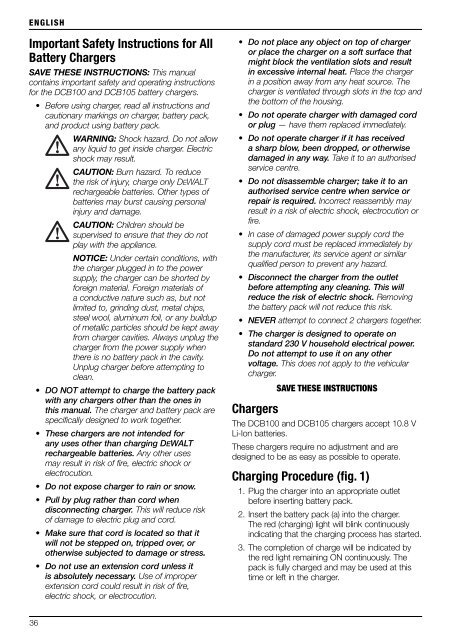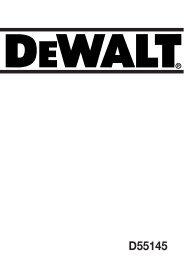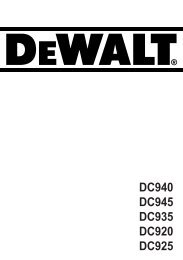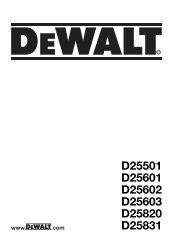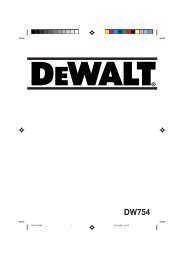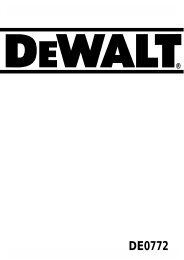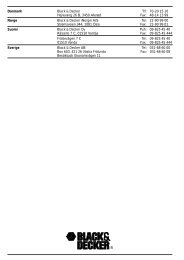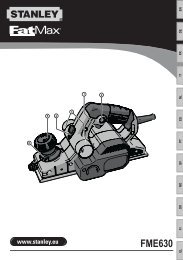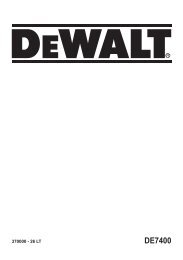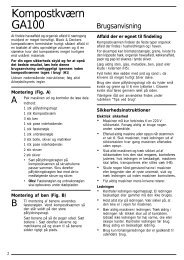N170801 man imaging therm DCT416 Euro.indd - Service
N170801 man imaging therm DCT416 Euro.indd - Service
N170801 man imaging therm DCT416 Euro.indd - Service
Create successful ePaper yourself
Turn your PDF publications into a flip-book with our unique Google optimized e-Paper software.
ENGLISH<br />
Important Safety Instructions for All<br />
Battery Chargers<br />
SAVE THESE INSTRUCTIONS: This <strong>man</strong>ual<br />
contains important safety and operating instruc tions<br />
for the DCB100 and DCB105 battery chargers.<br />
36<br />
• Before using charger, read all instructions and<br />
cautionary markings on charger, battery pack,<br />
and product using battery pack.<br />
WARNING: Shock hazard. Do not allow<br />
any liquid to get inside charger. Electric<br />
shock may result.<br />
CAUTION: Burn hazard. To reduce<br />
the risk of injury, charge only DEWALT<br />
rechargeable batteries. Other types of<br />
batteries may burst causing personal<br />
injury and damage.<br />
CAUTION: Children should be<br />
supervised to ensure that they do not<br />
play with the appliance.<br />
NOTICE: Under certain conditions, with<br />
the charger plugged in to the power<br />
supply, the charger can be shorted by<br />
foreign material. Foreign materials of<br />
a conductive nature such as, but not<br />
limited to, grinding dust, metal chips,<br />
steel wool, aluminum foil, or any buildup<br />
of metallic particles should be kept away<br />
from charger cavities. Always unplug the<br />
charger from the power supply when<br />
there is no battery pack in the cavity.<br />
Unplug charger before attempting to<br />
clean.<br />
• DO NOT attempt to charge the battery pack<br />
with any chargers other than the ones in<br />
this <strong>man</strong>ual. The charger and battery pack are<br />
specifically designed to work together.<br />
• These chargers are not intended for<br />
any uses other than charging DEWALT<br />
rechargeable batteries. Any other uses<br />
may result in risk of fire, electric shock or<br />
electrocution.<br />
• Do not expose charger to rain or snow.<br />
• Pull by plug rather than cord when<br />
disconnecting charger. This will reduce risk<br />
of damage to electric plug and cord.<br />
• Make sure that cord is located so that it<br />
will not be stepped on, tripped over, or<br />
otherwise subjected to damage or stress.<br />
• Do not use an extension cord unless it<br />
is absolutely necessary. Use of improper<br />
extension cord could result in risk of fire,<br />
electric shock, or electrocution.<br />
• Do not place any object on top of charger<br />
or place the charger on a soft surface that<br />
might block the ventilation slots and result<br />
in excessive internal heat. Place the charger<br />
in a position away from any heat source. The<br />
charger is ventilated through slots in the top and<br />
the bottom of the housing.<br />
• Do not operate charger with damaged cord<br />
or plug — have them replaced immediately.<br />
• Do not operate charger if it has received<br />
a sharp blow, been dropped, or otherwise<br />
damaged in any way. Take it to an authorised<br />
service centre.<br />
• Do not disassemble charger; take it to an<br />
authorised service centre when service or<br />
repair is required. Incorrect reassembly may<br />
result in a risk of electric shock, electrocution or<br />
fire.<br />
• In case of damaged power supply cord the<br />
supply cord must be replaced immediately by<br />
the <strong>man</strong>ufacturer, its service agent or similar<br />
qualified person to prevent any hazard.<br />
• Disconnect the charger from the outlet<br />
before attempting any cleaning. This will<br />
reduce the risk of electric shock. Removing<br />
the battery pack will not reduce this risk.<br />
• NEVER attempt to connect 2 chargers together.<br />
• The charger is designed to operate on<br />
standard 230 V household electrical power.<br />
Do not attempt to use it on any other<br />
voltage. This does not apply to the vehicular<br />
charger.<br />
SAVE THESE INSTRUCTIONS<br />
Chargers<br />
The DCB100 and DCB105 chargers accept 10.8 V<br />
Li-Ion batteries.<br />
These chargers require no adjustment and are<br />
designed to be as easy as possible to operate.<br />
Charging Procedure (fi g. 1)<br />
1. Plug the charger into an appropriate outlet<br />
before inserting battery pack.<br />
2. Insert the battery pack (a) into the charger.<br />
The red (charging) light will blink continuously<br />
indicating that the charging process has started.<br />
3. The completion of charge will be indicated by<br />
the red light remaining ON continuously. The<br />
pack is fully charged and may be used at this<br />
time or left in the charger.


